
Annie Montague Alexander was an explorer, naturalist, paleontological collector, and philanthropist.

Rollo Howard Beck was an American ornithologist, bird collector for museums, and explorer. Beck's petrel and three taxa of reptiles are named after him, including a subspecies of Galápagos tortoise, Chelonoidis nigra becki from Volcán Wolf. A recent paper by Fellers examines all the known taxa named for Beck. Beck was recognized for his extraordinary ability as a field worker by Robert Cushman Murphy as being "in a class by himself," and by University of California at Berkeley professor of zoology Frank Pitelka as "the field worker" of his generation.
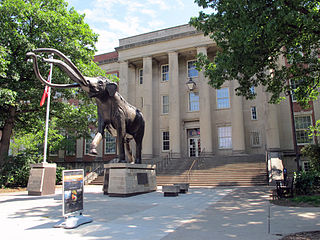
The University of Nebraska State Museum, also known as Morrill Hall, founded in 1871, is a natural history museum featuring Nebraska biodiversity, paleontology, and cultural diversity, located on the University of Nebraska–Lincoln City Campus near the corner of 14th and Vine Streets in Lincoln, Nebraska, United States. The museum houses Mueller Planetarium, a hands-on science discovery center, and the Elephant Hall, where visitors can see the world's largest articulated fossil mammoth among the collection of fossil elephants. Also featured are interactive paleontology exhibits, a dinosaur gallery, ancient life and evolution exhibits, wildlife dioramas, gems and minerals, American Indian and African exhibits, and a temporary exhibit gallery featuring rotating displays on diverse topics including photography, quilts and fine arts.
Vertebrate zoology is the biological discipline that consists of the study of Vertebrate animals, i.e., animals with a backbone, such as fish, amphibians, reptiles, birds and mammals. Many natural history museums have departments named Vertebrate Zoology. In some cases whole museums bear this name, e.g. the Museum of Vertebrate Zoology at the University of California, Berkeley.
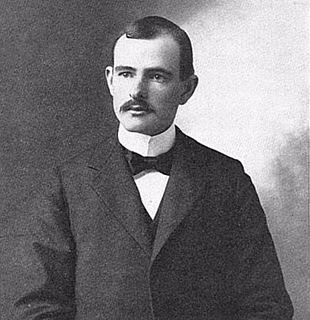
Joseph Grinnell was an American field biologist and zoologist. He made extensive studies of the fauna of California, and is credited with introducing a method of recording precise field observations known as the Grinnell System. He served as the first director of the Museum of Vertebrate Zoology at the University of California, Berkeley from the museum's inception in 1908 until his death.
David Burton Wake was an American herpetologist. He was professor of integrative biology and Director and curator of herpetology of the Museum of Vertebrate Zoology at the University of California, Berkeley. Wake is known for his work on the biology and evolution of salamanders as well as general issues of vertebrate evolutionary biology. He has served as president of the Society for the Study of Evolution, the American Society of Naturalists, and American Society of Zoologists. He was a member of the American Association for the Advancement of Science, the Linnean Society of London, the American Academy of Arts and Sciences, the American Philosophical Society, and in 1998 was elected into the National Academy of Sciences. He was awarded the 2006 Leidy Award from the Academy of Natural Sciences of Philadelphia.

The Museum of Comparative Zoology is a zoology museum located on the grounds of Harvard University in Cambridge, Massachusetts. It is one of three natural-history research museums at Harvard, whose public face is the Harvard Museum of Natural History. Harvard MCZ's collections consist of some 21 million specimens, of which several thousand are on rotating display at the public museum. In July 2021, Gonzalo Giribet, Alexander Agassiz Professor of Zoology at Harvard and Curator of Invertebrate Zoology, was announced as the new director of the museum.

The University of California Museum of Paleontology (UCMP) is a paleontology museum located on the campus of the University of California, Berkeley.
William Alvin Clemens Jr. was a paleontologist at the University of California at Berkeley. He was faculty of the Department of Paleontology from 1967, then the Department of Integrative Biology from 1994 to his retirement and curator of the UC Museum of Paleontology. Clemens was also director of the museum (1987–1989) and chair of the Department of Paleontology (1987–1989). He was awarded a Guggenheim Fellowship (1974–75), a U.S. Senior Scientist Award by the Alexander von Humboldt Foundation, the Romer-Simpson Medal (2006), and was made a Fellow of the California Academy of Sciences.

The University and Jepson Herbaria are two herbaria that share a joint facility at the University of California, Berkeley holding over 2,200,000 botanical specimens, the largest such collection on the US West Coast. These botanical natural history museums are on the ground floor of the Valley Life Sciences Building on the main campus of the university in Berkeley, California. There are ancillary collections such as the Marine Algal Collection, Fruit & Cone Collection, Horticultural Herbarium and Spirit Collection. The herbaria hold many type specimens, especially of Western North American and Pacific Rim plants. Holotypes are maintained separately for both herbaria. The Charterhouse School Herbarium is housed separately within the University Herbarium. The Herbaria have an open house every year on Cal Day with a range of activities for children and adults, and the Jepson Herbarium runs a series of workshops and public programs focusing on botanical education and the flora of California throughout the year.

The University of Michigan Museum of Natural History is a natural history museum in Ann Arbor, Michigan, United States. The museum recently moved to a new location at 1105 North University Avenue, in the University of Michigan Biological Sciences Building. It opened in April 2019.
Eustace L. Furlong was a paleontologist and fossil preparator noted for his work on ancient mammals and the Mesozoic reptiles of California.

Oliver Payne Pearson, or "Paynie" to many that knew him, was an American zoologist and ecologist. Over a very active 50-year career, he served as professor of zoology at UC Berkeley and curator of mammals at the Museum of Vertebrate Zoology. Pearson is best known for his work on the role of predation on vole demography and population cycles, and for his piercing contributions to the biology of South American mammals, but his earlier studies on reproductive and physiological ecology are highly regarded as well.
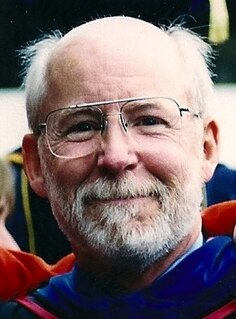
James Lloyd Patton, is an American evolutionary biologist and mammalogist. He is emeritus professor of integrative biology and curator of mammals at the Museum of Vertebrate Zoology, UC Berkeley and has made extensive contributions to the systematics and biogeography of several vertebrate taxa, especially small mammals.
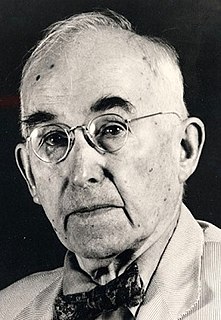
Tracy Irwin Storer (1889–1973) was an American zoologist known for his contributions to the wildlife of California and the ecology of the Sierra Nevada. He was a professor of zoology at the University of California, Davis for over 30 years. He served as president of several biological societies, including the Cooper Ornithological Club, Society of Ichthyologists and Herpetologists, the Society of Mammalogists, and the Wildlife Society, and was a fellow of the California Academy of Sciences which in 1968 awarded him the Fellow's Medal, the Academy's highest honor.

Alden Holmes Miller was an American ornithologist and director of the Museum of Vertebrate Zoology at the University of California, Berkeley for 25 years. He published over 250 papers on the biology, distribution, and taxonomy of birds, and served as president of the American Ornithologists' Union (1953-1955) and the International Commission on Zoological Nomenclature (1964-1965), and as editor of The Condor from 1939 until his death. He was a member of the National Academy of Sciences.

Robert Cyril Stebbins was an American herpetologist and illustrator known for his field guides and popular books as well as his studies of reptiles and amphibians. His Field Guide to Western Reptiles and Amphibians, first published in 1966, is still considered the definitive reference of its kind, owing to both the quality of the illustrations and the comprehensiveness of the text. A professor of zoology at the University of California, Berkeley, for over 30 years, he was the first curator of herpetology at the Museum of Vertebrate Zoology, a 1949 Guggenheim fellow, and author of over 70 scientific articles. His discovery of the ring species phenomenon in Ensatina salamanders is now a textbook example of speciation, and he performed extensive research on the parietal eye of reptiles. He produced nature films, supported science education in primary grades, and organized conservation efforts that aided in the passing of the 1994 California Desert Protection Act. After retirement he continued to paint, collect field notes, and write books. Stebbins is commemorated in the scientific names of three species: Batrachoseps stebbinsi, the Tehachapi slender salamander; Anniella stebbinsi, a legless lizard; and Ambystoma tigrinum stebbinsi, the endangered Sonora tiger salamander.

Richard Marshall Eakin, was an American zoologist and professor at the University of California, Berkeley. He was widely known for portraying prominent historical scientists during some of his lectures; dressing in costume and speaking in character to entertain and inform his students. A 1953 Guggenheim fellow, he wrote several books and more than 200 scientific papers. His research focused on eyes and vision in animals, especially the parietal eye or "third eye" of vertebrates, as well as animal embryology. He served as chairman of the UC Berkeley Department of Zoology for over 10 years, was elected president of the Western Society of Naturalists and American Society of Zoologists, and was a fellow of the California Academy of Sciences.

Loye Holmes Miller, was an American paleontologist and zoologist who served as professor of zoology at the University of California, Los Angeles, University of California, Berkeley, and University of California, Davis.
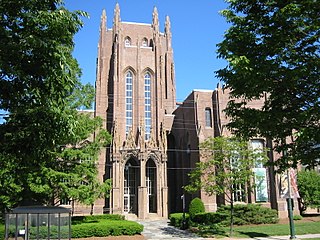
The Peabody Museum of Natural History at Yale University is among the oldest, largest, and most prolific university natural history museums in the world. It was founded by the philanthropist George Peabody in 1866 at the behest of his nephew Othniel Charles Marsh, the early paleontologist. Most known to the public for its Great Hall of Dinosaurs, which includes a mounted juvenile Brontosaurus and the 110-foot-long (34 m) mural The Age of Reptiles, it also has permanent exhibits dedicated to human and mammal evolution; wildlife dioramas; Egyptian artifacts; and the birds, minerals and Native Americans of Connecticut.

















